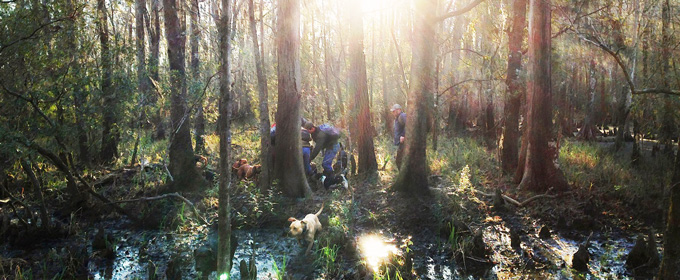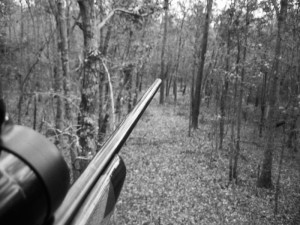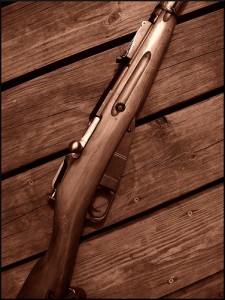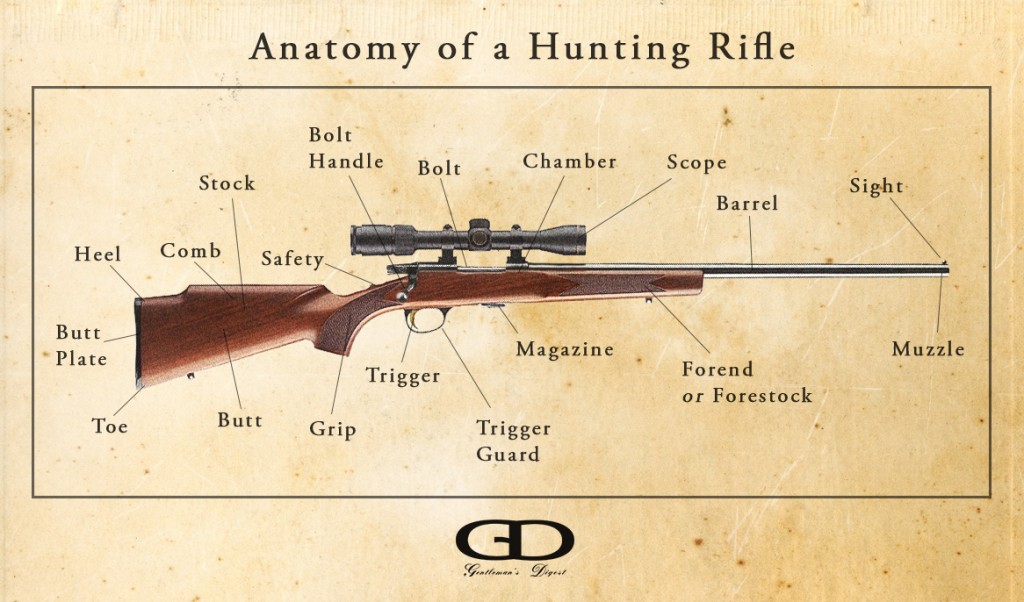
In the parts of the world where hunting and firearm sporting is still responsibly preserved and respected, we hope that our fellow gentlemen are making time to leave the office and head to the outdoors as much as possible. For those of us who grew up at least some of the time tracking deer beneath the shade of oak trees and watchful eyes of sentry squirrels, we know the peace that can come with embarking on a brisk morning hunt. There are many tools of the trade, from cross-bows to muzzle-loaders, but in this article we feature the most widely utilized: the high-powered hunting rifle.
 As part of this outdoor ritual, every huntsman knows there is a particular bond between him and his rifle. Just as a musician knows his guitar, or a painter his brushes, a hunter has an especial familiarity with his lock, stock and barrel. He may choose it, or it may be given to him by a friend or family member. He sights it to ensure accuracy and precision. He cleans it to maintain its health. He treats it with respect because of its inherent purpose: it is a tool to kill. Yet it connects him to the woods and his prey in a timeless manner of symbiosis that can only be understood by experience.
As part of this outdoor ritual, every huntsman knows there is a particular bond between him and his rifle. Just as a musician knows his guitar, or a painter his brushes, a hunter has an especial familiarity with his lock, stock and barrel. He may choose it, or it may be given to him by a friend or family member. He sights it to ensure accuracy and precision. He cleans it to maintain its health. He treats it with respect because of its inherent purpose: it is a tool to kill. Yet it connects him to the woods and his prey in a timeless manner of symbiosis that can only be understood by experience.
If you are beginning your journey into the outdoors and seeking your first hunting rifle, this is a guide for you. A rifle is personal and should be chosen accordingly, but we hope that this overview will help tremendously. While the modern arms enthusiasts are raiding gun shops for plastic military replicas in a “be cool” fervor, you should be on the trail of a gun that is timeless.
Join us in navigating the following 3 key elements: lock, stock, and barrel.
Overview
Lock
The action, or “lock”, of the rifle, is where most of the magic happens. It’s not the aim, not the steady, and not the guide: it’s the boom. The long short is that an action is what transfers a cartridge (bullet, casing, primer and powder load) from its storage compartment (magazine) to the chamber of the barrel and ignites the powder with the help of the trigger.
There are five basic types of action in a hunting rifle:
 Bolt – a handled bolt that extends from the action must be turned up by the user, pulled back to release (and or load) the cartridge, push to return forward the new cartridge, and lock back down into ready position.
Bolt – a handled bolt that extends from the action must be turned up by the user, pulled back to release (and or load) the cartridge, push to return forward the new cartridge, and lock back down into ready position.- Hinge – a hinge action, or “crack” barrel, is released using a pin that allows a spring loaded process to eject the cartridge. The new cartridge is manually inserted and then closed again by the user.
- Lever – you may remember the famous “Spencer repeating rifle” that helped influence the course of the American Civil War. A lever action is a handled lever below the trigger that is extended and then closed by the user to eject and load the cartridges. While faster and more efficient than a bolt action, this function demands more space and physical maneuverability for the shooter. (As opposed to a bolt action, where the trigger arm can reload and shoot again without moving the body at all)
- Pump – this alternative process allows the bracing arm at the forend of the rifle to pull back and reload the rifle (similar to a pump action shot gun)
- Semi-Automatic – a semi-automatic action releases and reloads the chamber by using the force of the previous shot’s combustion in the bore to drive back the bolt and ready the next shot.
Recommendation
The most classic and versatile action for your first hunting rifle is the bolt-action. It is basic, dependable, safe, and most certain to go boom.
Stock

The stock is somewhat comparable to the body of a car. It doesn’t make it go faster, load and unload, or do much entirely on its own. However, it is the key part of the rifle that hold’s everything together, absorbs shock, fits the gun to your body, and makes or breaks the look of your gun.
Material – there are many wood and synthetic varieties used to make rifle stocks. A classic look is a hard wood of darker or natural stain. Walnut is by far the most prevalent for its weight, shock absorbency, and look. Rosewood, beechwood, and other materials might also be incorporated for the grip cap or forend.
![]() Finish – commonly, the finish will be a lacquer gloss or satin, more natural texture. A synthetic will also have a matte coat that gives better grip than a smooth surface. In any case, the stock is often “checkered” (cross-hatched grooves cut into the outside of the stock near the grip and forend) to provide optimal handling for any texture.
Finish – commonly, the finish will be a lacquer gloss or satin, more natural texture. A synthetic will also have a matte coat that gives better grip than a smooth surface. In any case, the stock is often “checkered” (cross-hatched grooves cut into the outside of the stock near the grip and forend) to provide optimal handling for any texture.
Form – again, a stock can be made like a 1980 Volvo sedan or a curvaceous Aston Martin DBS. For your first and timeless hunting rifle, look for something that is both functional and form-fitting. A straight-back comb (the top of the stock between the grip and butt) near your cheek is both streamlined and forgiving if there is a great deal of recoil in the shot. However, you may want a raised “Monte Carlo” or rollover comb if you are using a higher mounted scope.
Finally and most importantly, it needs to fit you. The butt of the rifle should fit square and snug in the pocket of your shoulder, the comb should line your cheek where your dominant eye is centered on the sights or scope, and the trigger should be comfortable right in the bend of your finger from a shouldered position. Make sure you’re not stretching to reach that trigger, or the rest of your body will maladjust accordingly. Take your time and shoulder your prospects with consideration – this is “the one.”
Recommendation
A Weatherby Mark V Deluxe is a great reference point for a classic look to a stock that preserves optimal function. A walnut stock with checkering comes with a Monte Carlo comb and semi-grip with a gorgeous grain.
Barrel
Parts & Terminology
Muzzle – the tip, or exit, of the barrel. “Muzzle-loaders” get their name from the process of loading the gun directly from the muzzle.
 Bore – the inside of the barrel. Whereas most shotgun bores are smooth, a rifle is – well – rifled (a spiraled groove cut into the bore to spin the bullet and create aerodynamic balance once it leaves the barrel). Early muskets were smooth with a spherical shot, which gives you a good starting point toward inferring why they were so inaccurate.
Bore – the inside of the barrel. Whereas most shotgun bores are smooth, a rifle is – well – rifled (a spiraled groove cut into the bore to spin the bullet and create aerodynamic balance once it leaves the barrel). Early muskets were smooth with a spherical shot, which gives you a good starting point toward inferring why they were so inaccurate.
Twist – the distance of the barrel that it takes for the rifled groove, or the bullet itself, to complete one full twist. Typically this will be between 9-12 inches for a hunting rifle.
Caliber – the diameter of the bore. When you see “243, 270, etc,” that is the decimal (0.243) measure out of an inch. It will also correspond to the size and type of ammunition used to load the rifle (though these casings are technically, slightly smaller in diameter than their label)
- 45-70
- 30-30
- 30-06 (older class)
- 308 (modern class of 30-06)
- 270 (excellent deer caliber)
- 7mm-08 (“necked down” class of 30-06, also great for deer)
- 243
- 222
- 22
The Caliber is Crucial
It is worth saying very clearly that though we understate the importance of your caliber in choosing the model of your first hunting rifle, it is the most important variable to solve for. The projectile size, velocity (due to powder grain count), trajectory, and stopping power are what will ultimately determine which type of game you are able to hunt effectively. Our bias in this article is that a first rifle is meant to be the most versatile: not so big that it destroys a fox or bobcat, and not too small that it can’t stop a deer, hog, or even bear with deadly and sufficient force.
Color & Length
Color – most steel barrels are traditionally “blued”, or a glossy, dark gun-metal color. This is a result of chemically reacting the surface to help protect it from rust. However, more often the modern black or camouflage synthetic stocks are paired with a nickel-plated steel barrel or additionally use alternative protectants like lacquers and epoxies. If you are a classic gentleman, you will likely be attracted to the black barrel and stained wood stock. Alternatively, the synthetic and nickel arrangement can make a deadly-looking tool for the outdoors as well.
Length – the longer the barrel, the heavier the gun. It does not necessarily change the accuracy by any significant degree in a wooded or average-range hunt. A longer barrel will absorb more shock, but a shorter and lighter barrel is easier to carry and maneuver. Our suggestion: take the middle road (somewhere around a 22” barrel).
Recommendation:
For your first rifle, look for something between a 7mm-08 and a 30-06 caliber – a 270 is probably the sweet spot. These are the ideal calibers for hunting in forest and field. You may graduate to something larger for that big safari expedition down the road, but 99% of big game hunting will be most enjoyable and thoroughly satisfied by these caliber rifles.
Summary
Hopefully this has been helpful as you select a first rifle for yourself, your son, or a fellow Gentleman. There are far more details to be uncovered should you desire to become an expert on any of the topics covered above, but our effort was to give a basic overview.
In any case, remember that even though this may be a “first” hunting rifle experience, it should still be treated as a purchase for life – as with any firearms. Many experienced hunters will tell you that spending $4,000 or more on a designer shotgun never moved them to give up the $400 Remington 870 pump in the closet. After all, it’s still the gun that goes “bang.”
In summary, here are some great examples to start with, depending on your budget:
- Remington Model 700 Bolt Action in a 270 or 30-06 Caliber
- Remington Bolt Action Model Seven (shorter rifle)
- Ruger M77 Mark II
- Weatherby Mark V Deluxe
We wish you the best in your hunt for your first, timeless hunting rifle.
Disclaimer: as context for this article’s subject-matter, we strongly uphold the guidance of law enforcement and governing authorities on the uses and confines of firearms. Laws may prohibit some of our readers from owning or using firearms in their respective locales. Furthermore, any use of a rifle must be preceded by initial safety training and repeated precaution either alone or in the company of others. We offer our advice above only in the context of this disclaimer and ask that our fellow gentlemen act in such accordance.



